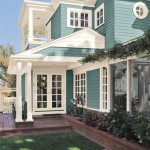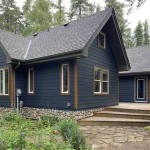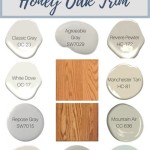What Colour To Paint A Stone Fireplace
Painting a stone fireplace is a transformative project that can dramatically alter the aesthetic of a room. The natural textures and inherent variations in stone provide a unique canvas, offering a multitude of design possibilities. However, the selection of the right paint colour requires careful consideration of various factors, including the style of the room, the type of stone, the existing décor, and the desired ambiance. This article explores the critical aspects of choosing the appropriate paint colour for a stone fireplace.
Before delving into specific color suggestions, it is vital to assess the existing stone. The colour of the stone itself will influence the final appearance of any paint applied. Some stones possess warm, earthy tones like browns, beiges, and reds, while others exhibit cooler shades of grey, blue, and even green. Understanding these inherent tones serves as a foundation for selecting a complementary or contrasting paint colour. Furthermore, the stone's texture – whether rough and rustic or smooth and polished – will affect how the paint is absorbed and reflects light, ultimately impacting the perceived colour.
Beyond the characteristics of the stone, the overall style of the room plays a significant role in determining the optimal paint colour. A modern, minimalist space may benefit from a stark white or a cool grey fireplace, creating a clean and contemporary focal point. Conversely, a traditional or rustic room might be enhanced by a warmer, more earthy tone, reinforcing the room's established character. Similarly, the existing décor, including furniture, wall colours, and accessories, must be considered to ensure a cohesive and harmonious aesthetic. A carefully selected paint colour can either blend seamlessly with the existing décor or provide a striking contrast, depending on the desired effect.
Assessing the Room's Lighting Conditions
The interplay of natural and artificial light within a room is a crucial factor in determining the perceived colour of a painted fireplace. Natural light, particularly the direction and intensity of sunlight, can dramatically alter the appearance of paint colours. South-facing rooms, which typically receive warm, direct sunlight, can handle cooler paint colours without appearing drab. North-facing rooms, on the other hand, tend to have cooler, indirect light, and may benefit from warmer paint colours to counteract the room's inherent coolness. Artificial lighting, including incandescent, fluorescent, and LED lights, also influences colour perception. Incandescent lights cast a warm, yellow glow, while fluorescent lights tend to emit a cooler, blue-tinged light. LED lights offer a range of colour temperatures, from warm to cool, requiring careful consideration when selecting a paint colour. It is advisable to test paint samples under different lighting conditions to accurately assess their appearance throughout the day and night.
The size of the room is another factor that influences paint colour selection. In smaller rooms, lighter paint colours tend to create a sense of spaciousness and airiness, while darker colours can make the room feel smaller and more enclosed. However, a dark-painted fireplace can serve as a dramatic focal point in a small room, provided the surrounding walls are painted in a lighter colour to maintain a sense of balance. In larger rooms, darker colours can be used more liberally without overwhelming the space. The height of the ceiling should also be considered. Low ceilings can be visually raised by painting the fireplace in a lighter colour than the surrounding walls, while high ceilings can be visually lowered by painting the fireplace in a darker colour.
Beyond the practical considerations of lighting and room size, the desired ambiance plays a significant role in determining the optimal paint colour. Warm colours, such as reds, oranges, and yellows, evoke feelings of warmth, comfort, and energy. These colours are often associated with traditional and rustic styles. Cool colours, such as blues, greens, and purples, create a sense of calm, serenity, and sophistication. These colours are often associated with modern and minimalist styles. Neutral colours, such as whites, greys, and beiges, offer versatility and can be adapted to a wide range of styles. They provide a blank canvas, allowing the other elements in the room to take centre stage. The choice of paint colour should reflect the desired mood and atmosphere of the space.
Exploring Popular Paint Colour Options
Several paint colours are consistently popular choices for stone fireplaces. White, in its various shades, remains a timeless classic. A crisp, clean white can brighten a room and create a sense of modernity. Off-white shades, such as cream or ivory, add a touch of warmth and sophistication. Grey, another versatile neutral, offers a range of options, from light and airy to dark and dramatic. Light grey shades can create a serene and calming atmosphere, while dark grey shades can add depth and sophistication. Beige, a warm neutral, provides a sense of comfort and earthiness. It complements a wide range of décor styles and creates a welcoming ambiance. Earth tones, such as browns, greens, and rusts, evoke a sense of nature and rusticity. These colours are particularly well-suited for traditional and rustic spaces. Finally, bold colours, such as blues, greens, and reds, can create a striking focal point and add personality to a room. These colours are best used in moderation and with careful consideration of the surrounding décor.
Within each of these broad colour categories, numerous specific paint colours offer unique characteristics. For example, within the white category, Benjamin Moore's "Simply White" is a popular choice for its clean and versatile nature, while Sherwin-Williams' "Alabaster" provides a slightly warmer alternative. In the grey category, "Pale Oak" by Benjamin Moore offers a soft and sophisticated look, while "Iron Ore" by Sherwin-Williams creates a dramatic and modern effect. For beige shades, "Edgecomb Gray" by Benjamin Moore offers a versatile and sophisticated option, while "Accessible Beige" by Sherwin-Williams provides a warmer and more inviting feel. Ultimately, the selection of a specific paint colour requires careful consideration of the stone's characteristics, the room's style, the existing décor, and the desired ambiance.
The finish of the paint also influences the final appearance of the painted fireplace. Matte finishes provide a smooth, non-reflective surface that hides imperfections and creates a sense of depth. They are well-suited for traditional and rustic spaces. Satin finishes offer a slight sheen that enhances the colour's vibrancy and provides increased durability. They are a versatile choice for a wide range of styles. Semi-gloss finishes provide a higher level of sheen and are easier to clean. They are often used in bathrooms and kitchens but can also be used on fireplaces to create a more modern and polished look. High-gloss finishes provide the most sheen and are highly durable. They are often used on trim and doors but can also be used on fireplaces to create a dramatic and reflective effect. The choice of paint finish should reflect the desired aesthetic and the level of maintenance required.
Preparation and Application Techniques
Proper preparation is essential for achieving a successful and long-lasting paint job. The stone surface must be thoroughly cleaned to remove any dirt, dust, grease, or loose particles. A wire brush can be used to scrub away stubborn debris. Any cracks or chips in the stone should be repaired with a suitable patching compound. Once the surface is clean and repaired, it should be primed with a masonry primer. Primer helps the paint adhere properly to the stone and prevents the paint from being absorbed unevenly. It also helps to seal the stone and prevent moisture from penetrating the surface. The application of paint should be done in thin, even coats, allowing each coat to dry completely before applying the next. Multiple coats may be necessary to achieve the desired coverage and colour intensity. A high-quality brush or roller should be used to ensure a smooth and even finish. Applying a sealant after painting can further protect the painted surface from moisture and wear.
Additionally, consider the type of paint being used. Latex paints are a common choice for interior painting projects due to their ease of use, low odor, and durability. However, for stone fireplaces, it is crucial to use a paint specifically formulated for masonry surfaces. These paints are designed to withstand the unique challenges posed by stone, such as its porous nature and potential for moisture absorption. Masonry paints are typically acrylic-based and offer superior adhesion, water resistance, and breathability. They allow moisture vapor to escape from the stone, preventing the paint from blistering or peeling. Oil-based paints are another option, offering exceptional durability and a rich, lustrous finish. However, they have a higher VOC content and require mineral spirits for cleanup. Regardless of the type of paint chosen, it is essential to follow the manufacturer's instructions carefully for optimal results.
Finally, before embarking on the entire project, it is highly recommended to test paint samples in an inconspicuous area of the fireplace. This allows for a realistic assessment of the colour's appearance under different lighting conditions and helps ensure that the chosen colour complements the overall style of the room. Testing also provides an opportunity to evaluate the paint's adhesion and coverage on the specific type of stone. By taking the time to test paint samples, potential mistakes can be avoided, and the final outcome can be confidently predicted.
Choosing the right paint colour for a stone fireplace is a multi-faceted decision that requires careful consideration of various factors. By assessing the stone's characteristics, the room's style, the existing décor, the lighting conditions, and the desired ambiance, one can make an informed decision and achieve a stunning transformation. Proper preparation and application techniques are also essential for ensuring a successful and long-lasting paint job.

How To Choose Colour Around A Stone Fireplace

Whitewashing A Stone Fireplace With Grey Paint Land Of Laurel

Black Painted Fireplace How To Paint Stone

Best Stone Fireplace Paint Colors You Should Consider Painting

Black Painted Fireplace How To Paint Stone

Any Advice On Paint Colors To Complement This Fireplace

How To Easily Paint A Stone Fireplace

How To Choose Colour Around A Stone Fireplace

Living Room Paint Colors With Wood Trim And Stone Fireplace Google Search

Painting Stone Fireplaces 8 Where Paint Created A Cozy Vibe Arinsolangeathome
Related Posts








